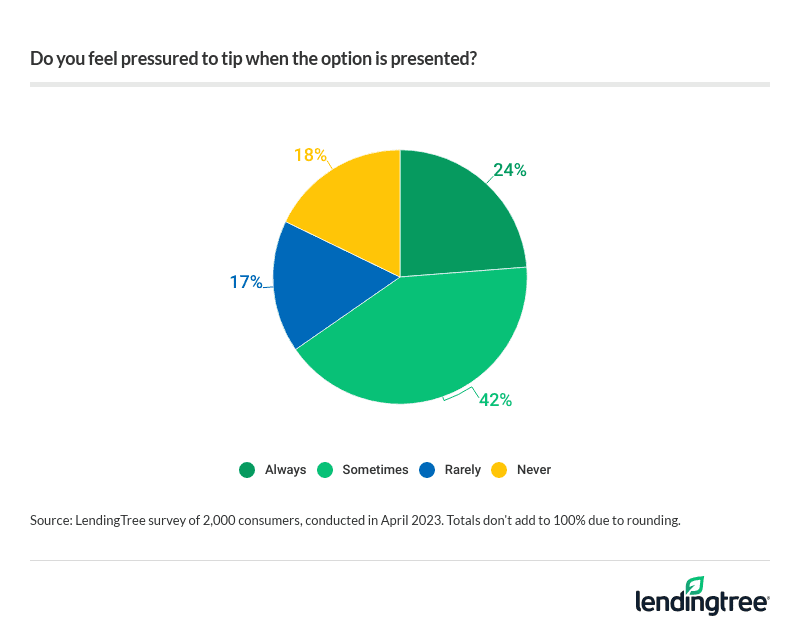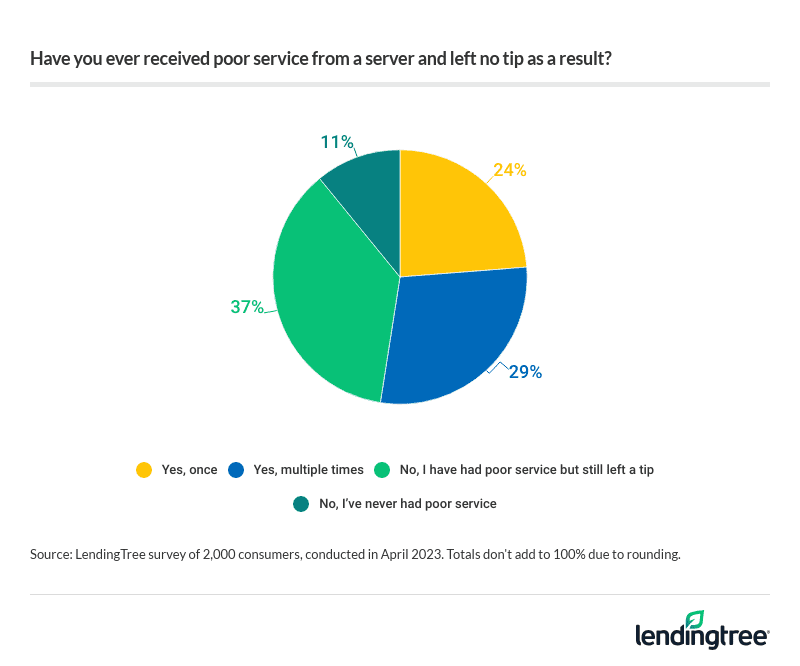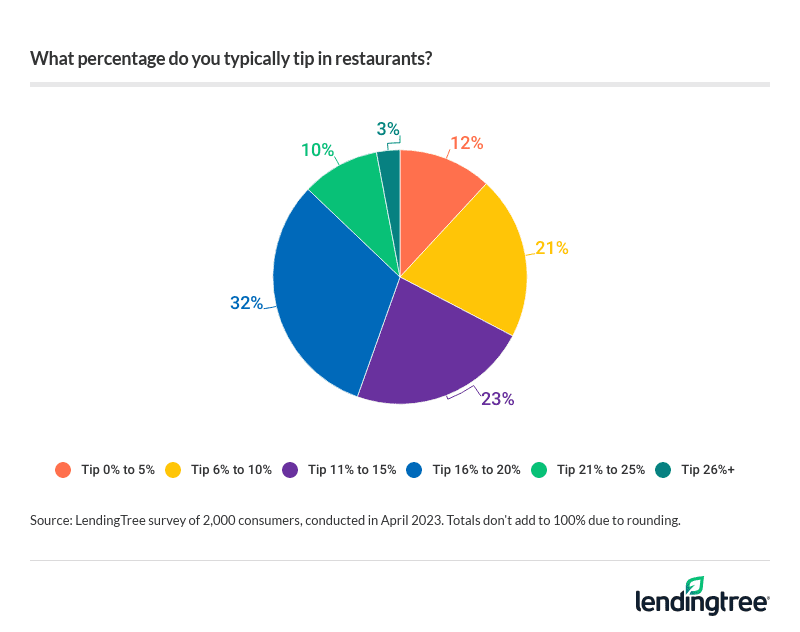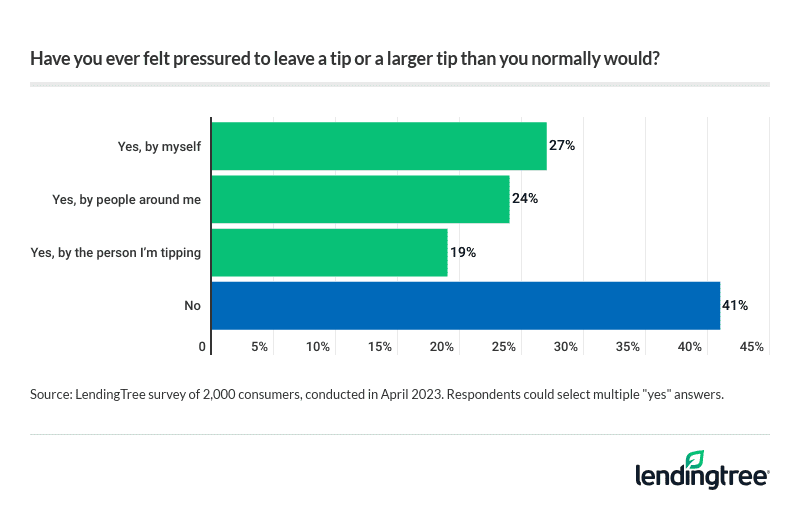Guilt Tip: 60% of Americans Say They’re Tipping More as Technology Nudges Consumers to Add Gratuity
Tipping has been a part of American culture for centuries, and the rise of technology has made it more convenient than ever. However, with increased convenience comes increased pressure, and Americans are feeling the heat. According to the latest LendingTree survey of 2,000 U.S. consumers, almost a quarter (24%) of Americans say they always feel pressured to tip when the option is presented.
We’ll go over whether consumers believe tipping has gotten out of hand, which services they’re most likely to tip for and how much they’re tipping. Plus, stick around for tips (see what we did there?) on accommodating tipping culture in your budget.
Key findings
- Thanks to the convenience technology provides, 60% of Americans say they’re now tipping more. But the heat is on for some when the handheld device or tablet flips to them. Almost a quarter (24%) of Americans say they always feel pressured to tip when the option is presented, with another 42% saying they sometimes do.
- The high frequency of tipping opportunities may be why 41% of Americans have changed their buying habits due to gratuity expectations, and 60% believe it’s gotten out of hand. Across generations, baby boomers are most likely to think tipping has gotten carried away, at 64%. Gen Zers are on the other end of the spectrum, at 54%.
- Only 44% of Americans think tipping should be mandatory in the service industry, but 84% say they believe the minimum wage for service workers should be increased. Even though most Americans think service workers should be paid more, 53% of consumers say they’ve received poor service and left no tip as a result, with 29% of them admitting it’s happened multiple times.
- About two-thirds (66%) of consumers say they always tip when dining out at bars or restaurants, but amounts vary widely. About a third (32%) of Americans say they typically tip between 16% and 20% at restaurants, with 55% generally adding 15% or less. Just 12% commonly add 21% or more to their bill.
- Tipping can impact Americans socially, with 30% admitting they would judge someone based on how much they tip. Consumers also express feeling the pressure to tip from others, with 24% saying they’ve felt obliged to tip more than they normally would by the people around them and 19% saying they felt pressure from the person serving them.
- Tipping woes could contribute to food and beverage stores seeing the biggest jump in retail sales among tracked industries between December 2021 and December 2022. Retail sales at grocery stores, specialty food stores and beer, wine and liquor stores are up 6.9% in this period.
60% of Americans say they’re now tipping more
As technology continues to make tipping more convenient, 60% of Americans say they’re tipping more often than before. That’s particularly true of younger Americans — Gen Zers (ages 18 to 26) are the most likely age group to say they’re tipping more at 73%. That’s followed by:
- Millennials (ages 27 to 42) (72%)
- Gen Xers (ages 43 to 58) (51%)
- Baby boomers (ages 59 to 77) (35%)
Accommodating for kids may increase the likelihood of receiving a tip, as consumers with children younger than 18 (72%) are more likely to say they’re tipping more now than those with no children (58%) and those with adult children (45%). In addition, high earners are more likely to say they’re tipping more now than low earners — 71% of six-figure earners say they’re adding gratuity more often, while just 53% of those earning less than $35,000 annually say similarly.
Meanwhile, men (63%) are more likely to say they’re tipping more now than women (56%).
But while technology has made tipping easier, not everyone thinks that’s a good thing. Among those who say tipping is easier now due to technology, 26% say they don’t like the pressure it brings.
Regardless, those handheld point-of-sale devices and tablets may put some heat on consumers. In fact, almost a quarter (24%) of Americans say they always feel pressured to tip when the option is presented, with another 42% saying they sometimes do.

Six-figure earners (34%) are the most likely to say they always feel pressured to tip, followed by consumers with children younger than 18 (28%) and millennials (28%).
According to LendingTree chief consumer finance analyst Matt Schulz, guilt tipping is a pretty common experience — and businesses are willing to take advantage of it.
“I think part of the reason why Americans tip out of guilt is that most people deep down want to be seen as generous with their money,” he says. “They don’t want to be known as a cheapskate who is a bad tipper, so they give a little bit more to feel better about themselves. Also, I think there’s some fear of repercussions for not tipping well. People might think that if they pay in advance and don’t tip well, the service they receive might suffer.”
41% have changed their shopping habits due to tipping expectations
With greater tipping opportunities comes greater responsibility — and many Americans shy away from that pressure. In fact, 41% of Americans have changed their buying habits due to gratuity expectations.
Those who’re more likely to say they’re tipping more are the same ones switching up their buying habits. By age group, millennials are most likely to say they’ve changed their buying habits due to gratuity expectations, at 49%. Meanwhile, baby boomers are least likely to change their habits, at 26%. Similarly, those with underage children (50%) are more likely to switch up their spending habits due to gratuity expectations than those with no children (37%) and those with adult children (32%).
Amid this, 60% believe tipping has gotten out of hand. Across generations, baby boomers (64%) are most likely to hold this belief, while Gen Zers (54%) are the least likely.
According to Schulz, consumers may feel that tipping has gotten out of hand because more businesses have begun presenting tipping options.
“Technology has made it so easy for businesses to implement tipping,” he says. “Most businesses run on such tiny profit margins that the ability to add a new revenue stream by doing nothing more than adjusting some settings on a payment terminal is a pretty appealing thing. Sure, some customers might get annoyed, but — ultimately — the customer can easily decline to tip by clicking a button on the terminal. There’s just so much upside, and businesses are so eager to bring in a little extra money on each transaction, that presenting tipping options becomes somewhat of a no-brainer.”
Should tipping be mandatory? Most consumers say no
Although many consumers always leave tips when the option is presented, only 44% of Americans think tipping should be mandatory in the service industry. Unsurprisingly, opinions vary by generation. Gen Zers are the most likely to support mandatory tipping (53%), while baby boomers are least likely to support it (30%).
Rather, consumers are more likely to support minimum wage hikes — 84% say they think the minimum wage for service workers should be increased so they don’t have to rely on tips as part of their income.
But even though most Americans think service workers should be paid more, more than half (53%) of consumers say they haven’t left a tip after receiving poor service, with 29% of them admitting it’s happened multiple times. And despite being the most likely age group to tip more often, Gen Zers are also the most likely group to say they’ve skipped the tip after bad service, at 60%. Meanwhile, baby boomers are the least likely to do so, at 42%.

Overall, 37% say they still left a tip even when they received poor service — and that’s particularly true among baby boomers (48%) and consumers with adult children (45%).
Majority of consumers always tip when dining out at bars or restaurants — here’s how much they’re tipping
When most people think of tipping, they think of dining out. In fact, nearly two-thirds (66%) of consumers say they always tip when dining out at bars or restaurants — but how much of a gratuity are they giving their servers?
As it turns out, the majority (55%) typically add 15% or less — less than what’s widely considered polite. Meanwhile, about a third (32%) of Americans say they typically tip between 16% and 20% at restaurants, which is largely considered the standard. Just 12% commonly add 21% or more to their bill.

Schulz says he’s disappointed there aren’t more people who regularly tip between 16% and 20% at restaurants.
“Sure, inflation is crazy and people’s budgets are tighter than usual these days, but the truth is that if you can’t afford to tip properly when you dine out, then maybe you just shouldn’t be dining out,” he says. “The folks serving you at that restaurant depend on those tips for a living. Those extra couple of dollars you saved by tipping poorly aren’t going to make any material difference in your life, but it absolutely can in the life of your server. Do the right thing. When in doubt, tip a little more.”
It’s not surprising that dining out is the top service Americans say they always tip for (66%), but what other services do consumers provide tips for? Half (50%) of consumers always tip for personal care services, while 45% always tip for delivery services — making them the next most popular services for tipping. On the other end of the list, child care is the least common service consumers always tip for, at 16%. Takeout (19%) and pet care (21%) follow.
When it comes to which factors play the biggest role in determining tip amounts, 59% say the quality of service matters most — by far the most popular option. That’s followed by:
- The type of service (16%)
- How much cash they have on hand (14%)
- Societal norms (7%)
- Length of service (5%)
Peer pressure and tipping: 30% would judge someone based on how much they tip
Some consumers may tip on the low end, but tipping culture is deeply ingrained in some people — in fact, 30% say they would judge someone based on how much they tip. That’s particularly true for six-figure earners (45%), millennials (39%) and parents with underage children (37%).

There’s some pressure on tippers, too, with 60% saying they’ve felt pressured to leave a larger tip than normally. To break that down further, 27% say they felt pressured by themselves, 24% say they have felt obliged to tip more than normally by the people around them and 19% say they felt pressure from the person serving them.
Amid increased tipping, food and beverage stores saw the biggest jump in retail sales
Amid these tipping woes, food and beverage stores saw the biggest jump in retail sales among tracked industries between December 2021 and December 2022. Retail sales at grocery stores, specialty food stores and beer, wine and liquor stores are up 6.9% in this period. Comparatively, retail sales across all tracked industries grew by 2.8% between December 2021 and December 2022.
Food and beverage sales grew year over year throughout 2022, peaking in April at 9.2% before slowing to 6.7% in May. In November, with holiday shopping picking up again, retail sales for food and beverage stores returned to a year-over-year jump of 8.5%.
Across all states, growth in retail sales at food and beverage stores jumped the most between December 2021 and December 2022 in Delaware (16.9%), Oklahoma (15.5%) and Idaho (10.8%). Meanwhile, retail food and beverage store sales fell in just one state in this period — the District of Columbia, by 1.6%.
Full rankings: Changes in food and beverage store sales between December 2021 and December 2022
| Rank | State | % growth |
|---|---|---|
| 1 | Delaware | 16.9% |
| 2 | Oklahoma | 15.5% |
| 3 | Idaho | 10.8% |
| 4 | Nevada | 9.6% |
| 4 | Ohio | 9.6% |
| 6 | California | 9.5% |
| 7 | Arkansas | 9.2% |
| 7 | Texas | 9.2% |
| 9 | Nebraska | 8.7% |
| 10 | Connecticut | 8.2% |
| 11 | Indiana | 7.9% |
| 12 | North Dakota | 7.8% |
| 13 | Louisiana | 7.7% |
| 14 | Michigan | 7.5% |
| 14 | West Virginia | 7.5% |
| 16 | South Carolina | 7.1% |
| 17 | Arizona | 6.8% |
| 18 | North Carolina | 6.7% |
| 19 | Tennessee | 6.6% |
| 19 | Virginia | 6.6% |
| 19 | Wisconsin | 6.6% |
| 22 | Missouri | 6.5% |
| 23 | Georgia | 6.4% |
| 23 | Kentucky | 6.4% |
| 25 | Maine | 6.4% |
| 26 | Kansas | 6.3% |
| 26 | Mississippi | 6.3% |
| 28 | New Hampshire | 6.2% |
| 29 | Florida | 6.1% |
| 29 | Illinois | 6.1% |
| 31 | New Jersey | 5.9% |
| 32 | Pennsylvania | 5.8% |
| 32 | Washington | 5.8% |
| 34 | Minnesota | 5.5% |
| 35 | Colorado | 5.3% |
| 36 | Montana | 4.8% |
| 37 | Alaska | 4.6% |
| 38 | South Dakota | 4.5% |
| 39 | Massachusetts | 4.3% |
| 40 | Iowa | 4.0% |
| 41 | New York | 3.7% |
| 42 | Oregon | 3.3% |
| 43 | Rhode Island | 3.2% |
| 44 | Vermont | 3.1% |
| 45 | New Mexico | 3.0% |
| 46 | Maryland | 2.8% |
| 47 | Utah | 2.7% |
| 48 | Wyoming | 2.4% |
| 49 | Hawaii | 2.1% |
| 50 | Alabama | 1.4% |
| 51 | District of Columbia | -1.6% |
Source: LendingTree analysis of U.S. Census Bureau Advance Monthly Retail Trade Survey data.
Providing gratuity without tipping your budget: Expert tips
With life getting more expensive by the day, tipping is an increasingly difficult habit to follow — but often necessary to support a server. To better budget for gratuity in a tumultuous economy, Schulz offers the following advice:
- It’s OK to vote with your feet. “If you think a company has overreached in how they’re asking for tips or even if asking for tips altogether, you can take your business elsewhere,” he says. “While I have no problem with restaurants using technology to nudge customers to tip a little more, I also understand that there are plenty of situations where it would be really unusual to be asked to tip. It could even be off-putting. If you feel a business is just going overboard, walk away.”
- Don’t penalize your server for their employers’ policies. “If a restaurant’s tipping options are a bit too high for you, don’t just get huffy and refuse to tip at all,” he says. “Make the extra click or two and enter in a custom tip that you feel is appropriate. If you don’t, you’re ultimately hurting the person who served you more than the business itself.”
- Budget for more tipping. “Savvy consumers adjust as financial circumstances change,” he says. “That’s certainly true when it comes to rising costs of goods and services. If you’ve noticed more businesses are asking for tips or that you’ve been tipping more often lately, don’t just ignore that trend. Account for it in your budget. It probably won’t make a big difference in your assumptions and calculations, but it’s not to be ignored either.”
- When in doubt, tip well. “Ultimately, it comes down to the fact that tipping matters,” he says. “It’s a big deal for service-industry workers who depend on tips for their livelihood. However, it can also be a win for customers. For example, it can be a way to build a relationship with a business you plan to use again. That’s true whether it’s a business in which tipping is expected or one in which it’s rare. It doesn’t mean you have to wreck your budget by throwing extravagant tips at everyone you come across, but it’s important to understand that even a little bit extra can have a real impact.”
Methodology
LendingTree commissioned Qualtrics to conduct an online survey of 2,000 U.S. consumers ages 18 to 77 from April 3 to 5, 2023. The survey was administered using a nonprobability-based sample, and quotas were used to ensure the sample base represented the overall population. Researchers reviewed all responses for quality control.
We defined generations as the following ages in 2023:
- Generation Z: 18 to 26
- Millennial: 27 to 42
- Generation X: 43 to 58
- Baby boomer: 59 to 77
Get debt consolidation loan offers from up to 5 lenders in minutes
- Key findings
- 60% of Americans say they’re now tipping more
- 41% have changed their shopping habits due to tipping expectations
- Should tipping be mandatory? Most consumers say no
- Majority of consumers always tip when dining out at bars or restaurants — here’s how much they’re tipping
- Amid increased tipping, food and beverage stores saw the biggest jump in retail sales
- Providing gratuity without tipping your budget: Expert tips
- Methodology
Read more
Nearly 70% of Americans Say They’re Dining Out Less Frequently Due to Inflation, and Almost a Third Are Tipping Less Updated August 30, 2022 Most Americans are feeling the severe effects of inflation, and the restaurant and grocery industries…Read more
BNPL Tracker: 41% of Users Late in Past Year, More Using Loans for Groceries Updated December 20, 2021 41% of users of buy now, pay later (BNPL) loans say they paid late on…Read more

